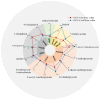Comparative Profiling of Hot and Cold Brew Coffee Flavor Using Chromatographic and Sensory Approaches
- PMID: 36230042
- PMCID: PMC9562860
- DOI: 10.3390/foods11192968
Comparative Profiling of Hot and Cold Brew Coffee Flavor Using Chromatographic and Sensory Approaches
Abstract
Coffee brewing is a complex process from roasted coffee bean to beverage, playing an important role in coffee flavor quality. In this study, the effects of hot and cold brewing on the flavor profile of coffee were comprehensively investigated on the basis of chromatographic and sensory approaches. By applying gas chromatography-mass spectrometry and odor activity value calculation, most pyrazines showed higher contribution to the aroma profile of cold brew coffee over hot brew coffee. Using liquid chromatography, 18 differential non-volatiles were identified, most of which possessed lower levels in cold brew coffee than hot brew coffee. The sensory evaluation found higher fruitiness and lower bitterness and astringent notes in cold brew coffee than hot brew coffee, which was attributed by linalool, furfural acetate, and quercetin-3-O-(6″-O-p-coumaroyl) galactoside. This work suggested coffee brewing significantly affected its flavor profile and sensory properties.
Keywords: aroma; chromatography; coffee; non-volatile; sensory profile.
Conflict of interest statement
The authors declare no conflict of interest.
Figures


References
-
- Pham Y., Reardon-Smith K., Mushtaq S., Cockfield G. The impact of climate change and variability on coffee production: A systematic review. Clim. Change. 2019;156:609–630. doi: 10.1007/s10584-019-02538-y. - DOI
-
- International Coffee Organization Historical Data on the Global Coffee Trade. [(accessed on 14 February 2022)]. Available online: http://www.ico.org/new_historical.asp?section=Statistics.
-
- Sunarharum W.B., Williams D.J., Smyth H.E. Complexity of coffee flavor: A compositional and sensory perspective. Food Res. Int. 2014;62:315–325. doi: 10.1016/j.foodres.2014.02.030. - DOI
-
- Cordoba N., Fernandez-Alduenda M., Moreno F.L., Ruiz Y. Coffee extraction: A review of parameters and their influence on the physicochemical characteristics and flavour of coffee brews. Trends Food Sci. Technol. 2020;96:45–60. doi: 10.1016/j.tifs.2019.12.004. - DOI
-
- McCain-Keefer H.R., Meals S., Drake M.A. The sensory properties and consumer acceptance of cold brew coffee. J. Sens. Stud. 2020;35:e12604. doi: 10.1111/joss.12604. - DOI
LinkOut - more resources
Full Text Sources

